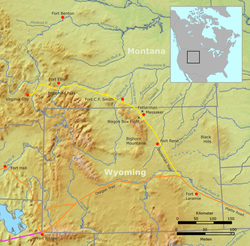Fetterman massacre
| Fetterman Fight | |||||||
|---|---|---|---|---|---|---|---|
| Part of Red Cloud's War, Sioux Wars, American Indian Wars | |||||||
 The Bozeman trail and the location of the Fetterman Fight. |
|||||||
|
|||||||
| Belligerents | |||||||
| United States |
Lakota Northern Cheyenne Northern Arapaho |
||||||
| Commanders and leaders | |||||||
|
William J. Fetterman† Frederick Brown† George W. Grummond† |
High Backbone (Hump) Crazy Horse Man Afraid Of His Horses |
||||||
| Strength | |||||||
| 79 soldiers, 2 civilians | ~1,000 | ||||||
| Casualties and losses | |||||||
| 81 killed | Probably between 13 and 60 killed | ||||||
The Fetterman Fight, also known as the Fetterman Massacre or Battle of the Hundred-in-the-Hands, was a battle during Red Cloud's War on December 21, 1866, between the Lakota, Cheyenne, and Arapaho Indians and soldiers of the United States Army. All 81 men under the command of Captain William J. Fetterman were killed by the Indians. At the time, it was the worst military disaster ever suffered by the U.S. Army on the Great Plains. The battle led to an Indian victory, with the U.S. forces withdrawing from the area. The Fetterman Fight took place in Crow Indian treaty guaranteed land, where the Lakotas and their Indian allies were without consent from the Crows.
The battlefield is engulfed in a treaty territory for the first time in 1851. The Fort Laramie Treaty from that year has the area as Crow Indian land. The Lakota, the Cheyenne and the Arapaho accepted it as such. Tracking the dwindling herds of buffalo, the three tribes soon "ignored" the treaty boundaries agreed upon and invaded the Crow land. By 1860, the Crows saw their hunting grounds west of Powder River in the hands of their old Indian enemies.
In June 1866, Colonel Henry B. Carrington advanced from Fort Laramie into the Powder River country, the hunting grounds of the Lakota, Northern Cheyenne, and Northern Arapaho. His orders were to protect the emigrants traveling west along the Bozeman Trail. Carrington had 700 soldiers and 300 civilians in his command. He established three forts along the trail, including his headquarters at Fort Phil Kearny, near present-day Buffalo, Wyoming. All three forts were located in Crow Indian territory. The army used a treaty right to "establish roads, military and other post". About 400 of his soldiers and most of the civilians were stationed at Fort Kearny.
During the next few months, while Fort Kearny was under construction, Carrington suffered about 50 Indian attacks, which killed a total of over 20 soldiers and civilians. The Native American warriors, invariably mounted, generally appeared in groups of 20 to 100. Several of Carrington's junior officers pressed him to take the offensive. They increased their urging after November 3, when a cavalry company of 63 men arrived to reinforce the post. Leading the cavalrymen was Lieutenant Horatio S. Bingham. He was accompanied by infantry Captains William J. Fetterman and James W. Powell. Both had been assigned to Fort Kearney from the 18th Infantry's headquarters at Fort Laramie. Bingham and Fetterman were Civil War veterans, while Fetterman had a distinguished war record.
...
Wikipedia
